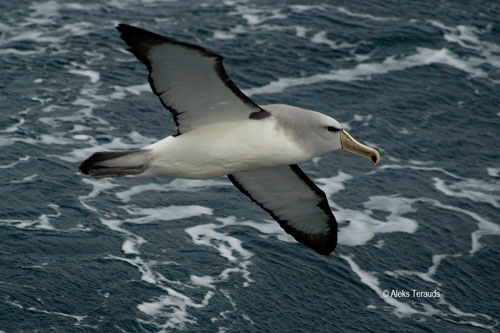David Thompson and colleagues (National Institute of Water and Atmospheric Research, New Zealand) have submitted a report (POP2012-06) to the Conservation Services Programme (CSP) of New Zealand’s Department of Conservation on differences in the at-sea distribution of Salvin’s Albatross Thalassarche salvini.
The report’s abstract follows:
“A total of 50 light-based geolocation data-logging devices were [sic] deployed on breeding Salvin’s albatrosses Thalassarche salvini at Proclamation Island, Bounty Islands, in October 2012. In October 2013, a return visit to the Bounty Islands resulted in the retrieval of 23 loggers, with a further six loggers accounted for but missing from the birds on which they were deployed. One additional logger was retrieved from a Salvin’s albatross killed as bycatch on a commercial fishing vessel. Twenty loggers remain at large and unaccounted for. Due to technical issues, all loggers had to be returned to the manufacturer in order for location data to be extracted. Of the 24 tags retrieved, data were extracted from 20, and of these seven sets proved to be unusable. The 13 usable data sets ranged in duration from 49 to 371 days, with a mean duration of 161 days. During incubation and chick-rearing, Salvin’s albatrosses from the Bounty Islands disperse both north (mostly) and south of the Bounty Islands, remaining towards the east of a line corresponding approximately to 170 degrees west. During the non-breeding period birds traversed the Pacific Ocean to occupy an area off the coast of Chile. Additional, comparative location data were included from Salvin’s albatross breeding at the Western Chain in the Snares group. Salvin’s albatross from the Western Chain similarly disperse north and south from the breeding site during incubation and chick-rearing, but tend to remain further to the west, approximately to the west of a line corresponding to 170 degrees west. During the non-breeding period, most Western Chain birds were off the coast of Chile, but a second group of birds occupied an area off the coast of Peru further to the north, between 10 and 20 degrees south. Also, one bird from the Western Chain remained in Australasian seas throughout the non-breeding period. The differences in distribution of the two populations of Salvin’s albatross in New Zealand waters have clear implications for exposure to risk from commercial fishing operations. However, the relatively small number of data sets acquired from Salvin’s albatrosses from the Bounty Islands preclude from drawing firm conclusions with respect to the non-breeding distribution in particular: questions around whether Bounty Islands birds occupy a single zone off Chile during this period, or whether they also occur off Peru and remain in Australasia, remain to be definitely answered.”

Salvin's Albatross, photograph by Aleks Terauds
Reports made to earlier meetings of the CSP on ACAP-listed species and on mitigation activities are also available on-line (click here).
With thanks to Barry Baker for information.
Reference:
David Thompson, D., Sagar, P., Torres, L. & Charteris, M. 2014. Salvin’s albatrosses at the Bounty Islands: at-sea distribution. Draft Final Report prepared for Department of Conservation July 2014. National Institute of Water and Atmospheric Research. 13 pp.
John Cooper, ACAP Information Officer, 30 July 2014

 English
English  Français
Français  Español
Español